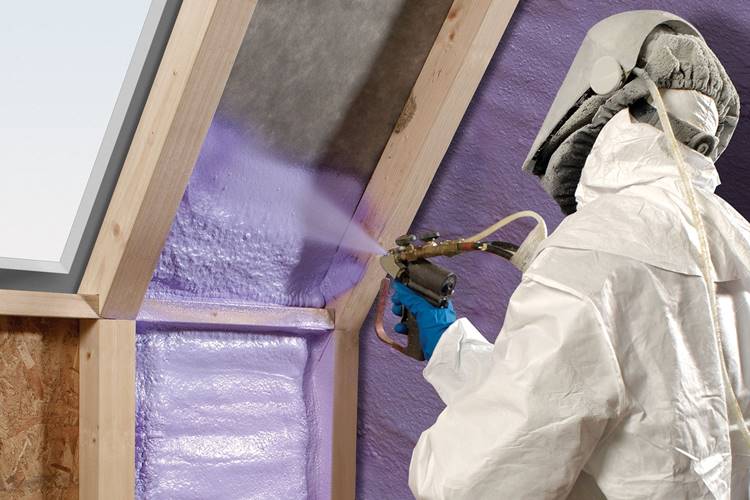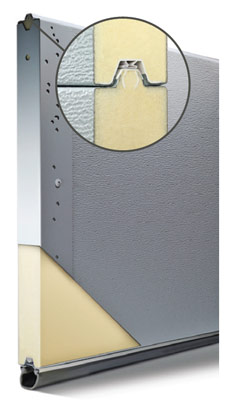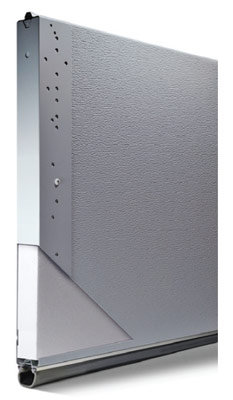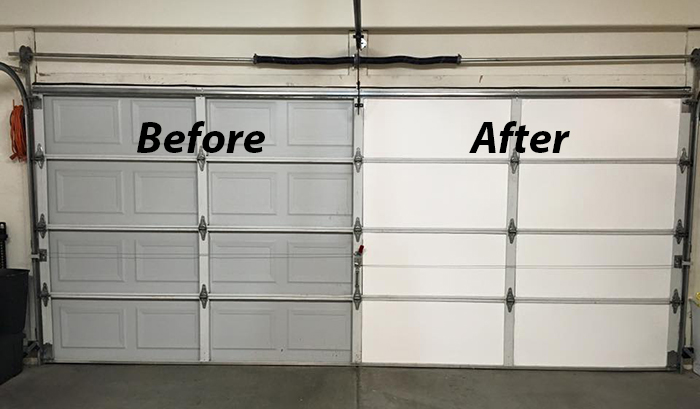Garage Insulation Guide: Types, Benefits, and Professional Tips

When most folks think about adding insulation to their home, they think about rolling out thick layers of foil-backed insulation in the attic or even upgrading the insulation in their exterior walls. Some will look to new double or triple-pane windows to help keep precious heat inside the home where it belongs. While these are good ideas, the garage is another part of the house that should always be considered in terms of insulation efforts. In this article, we will discuss the many benefits and then move on to tips on how to do it.
Garage Door Insulation Types
Whether you're about to undergo a new garage door installation or have an older door to which you would like to add insulation, you have two basic insulation choices: polyurethane or polystyrene. They're lauded to different degrees for their ability to keep your expensive heated air inside the house where it belongs, but there are important differences between the two. Let's look at those differences now.
"The R-value for insulation is a way to measure how much resistance the insulation has to heat flow. The higher the R-value, the more resistance and the better the material is at insulating a home."
—Derek Walczak, Forbes
Polyurethane Garage Door Insulation
Polyurethane insulation is sprayed directly into the garage door panels, filling the cavity and providing robust insulation. As the polyurethane sets, it also adds to the panel's rigidity, which increases the door's security profile while enhancing the R-value of the door. Polyurethane insulation was first developed 85 years ago and is used today in a variety of commercial and residential applications.
Of the two materials, polyurethane is the more expensive and the less flexible. By that, adding it to a door after installation is a non-starter. It needs to be injected into the panels during the panel manufacturing process. There have been instances of polyurethane being injected into panels on an existing door. Still, the cost of doing so is likely more than that of a new overhead door installation with a pre-insulated door.

Polystyrene Garage Door Insulation
Polystyrene is commonly known as Styrofoam, a popular insulation material that is both effective and relatively cheap. Polystyrene is either added to the garage door panels during manufacturing, or sheets can be added to the back of those panels long after the door has been installed.
When installed inside garage door panels, the polystyrene will not fill the cavity with the same thoroughness as injected polyurethane. Inevitably, there will be pockets of air, typically in the corners of each panel, and they can undercut its overall effectiveness. That's not to say polystyrene is ineffective. It works quite well, even when attached to the inside face of garage door panels after the fact. But when compared to polyurethane, it will not produce the same impressive R-value.

Which Type Of Garage Door Insulation Is Better?
"Better" is a relative term - the right choice for your home depends entirely on the characteristics that matter most to you. Review the following table to compare both insulation types' basic characteristics and advantages.
| Characteristic | Polyurethane Insulation | Polystyrene Insulation |
|---|---|---|
| Insulation Type | Spray foam | Foam board |
| R-Value (Thermal Resistance) | Higher (typically R-10 to R-17) | Lower (typically R-6 to R-10) |
| Durability | High | Moderate |
| Noise Reduction | Excellent | Good |
| Moisture Resistance | Excellent | Good |
| Energy Efficiency | High | Moderate |
| Installation | More complex, often requires professional installation | Easier, can be a DIY project |
| Cost | Higher | Lower |
| Weight | Adds more weight to the door | Adds less weight to the door |
| Aesthetic Appearance | Seamless, integrated look | May look bulky if not covered properly |
| Environmental Impact | Can have higher environmental impact due to chemicals | Lower environmental impact, often recyclable |
| Compatibility | Works well with most types of garage doors | May require adjustments for certain garage door types |
| Primary Advantages | Superior insulation, excellent durability, moisture and noise resistance | Lower cost, easier installation, environmentally friendly |
If you ask which one better retains heat, then the answer is polyurethane. However, it's more expensive than polystyrene, and you can't add it to an existing door after the fact. If you are working with a limited budget, then polystyrene may be your better choice. Likewise, polystyrene is the only one that can be added to the exterior of existing garage door panels to make them more energy-efficient.
The average home today is far more energy efficient than its predecessor of 40 years ago. Energy-efficient lights, double and triple-pane vinyl windows, high-efficiency furnaces, and more have cut the amount of energy a typical house today uses by more than 60% over the average home from 1975. That's pretty amazing. Yet one wasteful component of the typical home's energy profile routinely gets overlooked, even in today's energy-efficient environment: the garage door.
Benefits of a Well-Insulated Garage
The best way to prevent rising energy prices from overwhelming your budget is to ensure heat is not escaping needlessly into the atmosphere through poorly insulated walls and doors - including those in the garage. Below, we will look at some of the many benefits of having a well-insulated garage.
- Lower Energy Bills: Insulating your garage reduces heating costs in winter and cooling costs in summer by preventing heat loss and gain. This results in significant savings on energy bills.
- More Usable Space: Proper insulation can raise the garage temperature by 10-20℉, making it a usable space year-round. This allows you to consider what you might have ruled out before, like setting up a shop in your garage for woodworking or other projects.
- The Warm Domino Effect: The extra warmth in your garage can have an immediate domino effect on the adjoining spaces. The energy needed to heat the room or rooms above the garage can be drastically reduced, and heat loss through the walls and doorways of any rooms next to the garage on the first floor can be nearly eliminated.
- Added Comfort: A well-insulated garage ensures a less jarring temperature transition from house to car, improving overall comfort. This makes entering and exiting the garage more pleasant in extreme weather conditions.
- Reduced Noise: Steel garage doors whose panels are filled with polyurethane or polystyrene insulation are quieter than non-insulated doors. The insulation does more than provide a buffer between the cold and your garage space; it also absorbs many of the rattling sounds a door will naturally make when it's in motion, and, on top of that, it absorbs far more noise coming from the street.
- Increased Home Value: Insulating your garage enhances your home's market value by making it more energy-efficient and appealing to buyers. Homes with lower heating and cooling costs are more attractive to potential buyers.
- Healthier Car: Cars stored in insulated garages face less stress on batteries, tires, and fluids, enhancing performance and longevity. This results in fewer maintenance issues and better overall vehicle health.
- Increased Strength: An uninsulated garage door is far more susceptible to dings and dents than an insulated one. That's because the insulation within the panel will help the door absorb shocks from baseballs, basketballs, frisbees, and the like without denting. Your door will not only be more energy efficient but also stand up to normal wear and tear from having kids who play in the driveway.
- Better Overall Home Insulation: Including the garage in your insulation plan maximizes energy efficiency throughout the home. This contributes to a more consistent and comfortable indoor environment.
If you decide to replace your leaky, inefficient, non-insulated garage door with an insulated steel door from A Better Garage Door, remember to have proper weather seals installed as well, particularly along the bottom of the door. It's not uncommon for a garage door to sit less than perfectly against the ground. Proper weather sealing will fill any gaps, cracks, or depressions where cold air can leak in and undermine your energy conservation efforts.
Types of Interior Garage Insulation
A lot of times when we're called in to do garage door repair in Loveland we get asked which type of garage insulation is best. It depends. You can use two types of insulation in your garage: blown insulation or insulation that you unroll between the wall joists.
Blown Insulation
Blown insulation is a practical choice when your garage walls are covered with drywall. It provides a hassle-free installation without removing existing wall coverings, saving time and effort. This method effectively fills small gaps and crevices, offering comprehensive insulation that traditional batt insulation might miss.

| Pros | Cons |
|---|---|
| Suitable for garages with walls already covered in drywall | May require professional installation |
| Easier to install in existing structures without removing drywall | Can be more expensive than rolled insulation |
| Can fill small gaps and crevices effectively | Not as effective in fireproofing compared to rock wool rolled insulation |
Rolled Insulation
Rolled insulation is ideal for garages with unfinished walls and exposed joists. It comes in two varieties: fiberglass and rock wool, with rock wool offering superior fireproofing. This type of insulation requires the walls to be covered with drywall after installation to maximize its effectiveness.
| Pros | Cons |
|---|---|
| Ideal for unfinished garages with exposed wall joists | Requires removing and reinstalling drywall if walls are already finished |
| Comes in two types: fiberglass and rock wool | Can be less effective if not properly covered with drywall after installation |
| Rock wool variant offers better fireproofing | Installation can be labor-intensive |
| Generally less expensive than blown insulation |
How to Insulate Your Garage's Interior
While we're known for our top-rated Broomfield garage door repair services, the topic of insulating the garage is one our customers bring up frequently. Insulating the garage is an easy way to start saving on your energy bills, increase the usable space of the house, and make the process of entering and exiting the garage more comfortable while creating more high-quality storage space and increasing your home's value at the same time.
Installing the Insulation Properly
When adding rolled insulation to interior walls, you want the paper side of the insulation to face you while you work. In the garage, however, you'll want to ensure the insulation's fuzzy side - whether it's fiberglass or rock wool - is facing you when you install it. That's because the walls in the garage (even the hose shared by adjoining rooms) are exterior walls. So, the insulation needs to face the environment.
Air Sealing the Walls
You may also want to consider air-sealing your walls. Especially if they are unfinished. Air sealing the walls will make the insulation that much more effective. Air sealing entails using caulk and other readily available sealants to plug any cracks or holes in the walls. Most of these occur around pipes and wiring that run through the wall. The process isn't difficult, but it needs to be done before you install the rolled insulation. Once everything is in place, you must add the drywall above the top and seal it. If it's leaky, you'll want to fix the garage door, too.
To install blown insulation into finished walls, you'll need to create access holes in the walls. Make these using a hole saw and ensure they're between the joists, near the top of the wall. You'll also need to rent an insulation blower with a hose to get the insulation into the walls. It might require more than one person to do this effectively, so keep that in mind. Don't forget to seal the access holes when you're done.
Insulating Above the Ceiling
Some garages have a drop ceiling with a crawl space above that's often used for storage. Often, this ceiling is uninsulated, as is the roof at the top of the crawl space. Since heat rises, it's a good idea to insulate the drop ceiling and the roof if possible. If you don't have a drop ceiling, you should insulate the roof of the garage if it isn't already insulated
If you're contemplating adding insulation to your home, don't forget the garage. A well-insulated garage has benefits that include, but also go far beyond, savings on your energy bills.
DIY Garage Door Insulation: A Word of Caution
On a cautionary note: You may be tempted to retrofit your existing door with insulation to save a few bucks. However, that would be inadvisable and likely only cost you much more down the road. That's because:
- Adding insulation to an existing door substantially increases the door's weight. This means that the current lifting mechanism will likely need to be replaced. And by that, we mean the whole thing. Motor, springs, cables, the lot.
- Opening up the panels of your door to add insulation is asking for problems down the line. Unless you reassemble everything to factory standards, you'll likely experience leaking insulation and an overall loss of structural integrity.
The simple fact is you're far better off replacing your existing door with a new insulated door that garage door professionals properly install than you are trying to retrofit your old door.
Call Our Team for Insulated Garage Door Installations

At A Better Garage Door, we offer insulated steel garage doors that utilize either polyurethane or polystyrene insulation. Both will significantly reduce heat loss from your garage and, by extension, help keep your entire house warmer and save you money. Our polyurethane and polystyrene insulated steel doors feature:
- R-values as high as 17.19.
- 1.5" or 2" thick door sections.
- Heavy-gauge galvanized steel construction.
- A wide array of color choices and decorative options.
- Advanced tongue and groove design for optimal weather sealing.
- The ability to customize with optional Appearance Packages and Accent Planks.
Conclusion
Bring your garage into the energy-saving fold by installing energy-efficient insulated garage doors from A Better Garage Door. As the area's leading garage door repair experts, we see all types of garages, from those that have been finished to the point where they're practically livable to those that are just a few roughed in walls and a garage door. Many would benefit mightily from being insulated. If you would like some further advice on garage insulation or you need a garage door opener replacement or Littleton garage door repairs, give us a call and speak to one of our highly trained garage door service professionals.